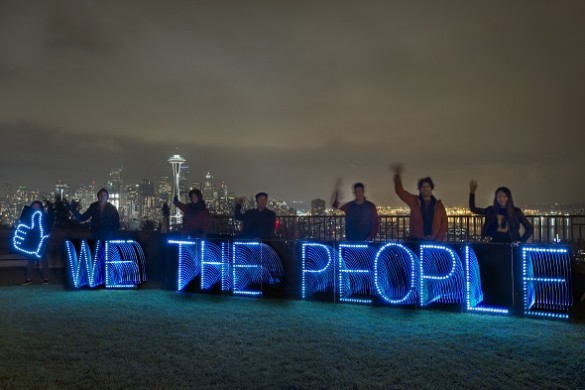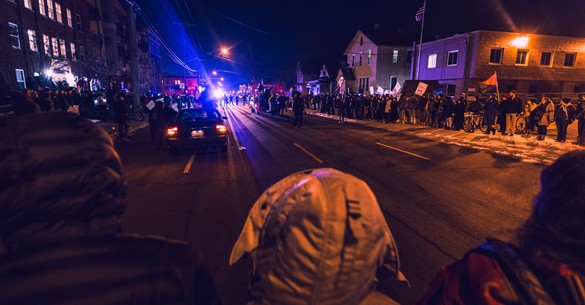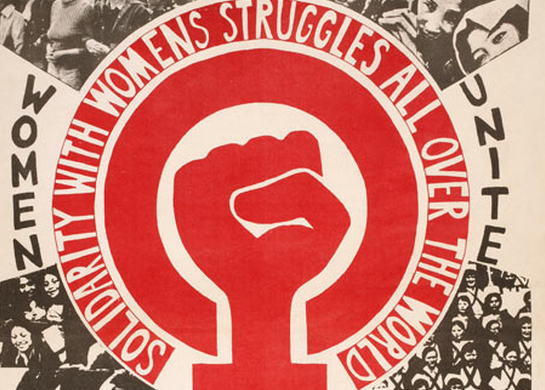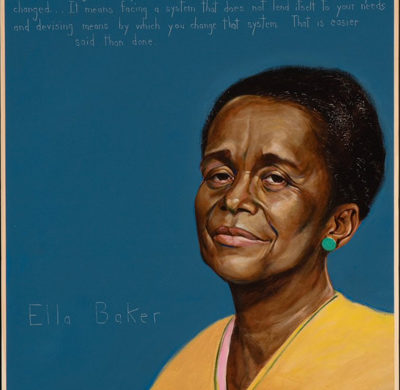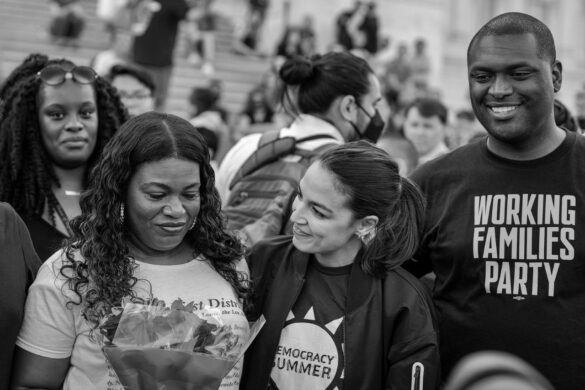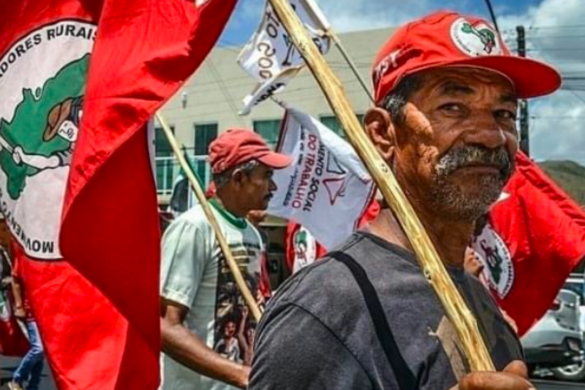As the left increasingly focuses on electoral politics, a new framework is emerging for how candidates who win should partner with social movements.
[Editor’s note: This article is the first in a series on the idea of co-governance. This first part looks at the history of the term and why co-governance has emerged as a topic of social movement discussion in the current political moment. The second part examines the actual practices that make up co-governance, as well as common tensions that arise between movements and the elected officials they put into office. A link to Part II is included at the end of this article. These articles are included in a July 2022 report, A Guide to Co-Governance: Can Movements and Politicians Work Together?]
By Mark and Paul Engler
(Published in Waging Nonviolence)
[Editor’s note: This article is the first in a two-part series on the idea of co-governance. This first part looks at the history of the term and why co-governance has emerged as a topic of social movement discussion in the current political moment. The second part examines the actual practices that make up co-governance, as well as common tensions that arise between movements and the elected officials they put into office. A link to Part II is included at the end of this article.]
“I believe in co-governance,” Congressional Representative Ilhan Omar said this past summer upon announcing funding for a spate of new community projects in Minneapolis. Yolanda Roth, a union organizer in her district who ran for county commissioner the year before, declared “co-governance is my passion.” Last fall, Sandy Nurse, a former Occupy Wall Street organizer who has now been elected to the New York City Council, made co-governance a core tenet of her campaign, calling for “a process where movements and community members aren’t only asked for their input, but are at the decision-making table, side by side, with decision-makers shaping legislation and policy.”
These politicians are not alone. Across the country, movements are increasingly demanding that elected officials adopt the concept of co-governance, and dozens — if not hundreds — of candidates backed by grassroots coalitions have embraced it.
In taking this stand, elected leaders and the organizations that back them are investing in an idea that a large swath of the public has likely never heard of, but one that is nevertheless gaining traction in progressive politics. So what does “co-governance” really mean? Where does it come from? What kind of problems does it seek to solve? And does it really represent something new in how organizers are approaching electoral politics?
Those promoting co-governance describe it as a new relationship between social movements and the candidates they help win office — a partnership in which activists and elected officials work to maintain a long-term relationship, closely coordinate strategy and advance grassroots priorities. But while this may be a compelling ideal, it is a devilishly hard one to realize in practice. The question of whether social movements can make co-governance a reality could well determine how far they can go in shaping the future of U.S. politics.
* * * * *
Beyond boom-and-bust elections
Behind growing interest in co-governance lies a key question: “What happens when we win?”
In the United States, social movement involvement in electoral campaigns often moves through a boom-and-bust cycle. The boom comes before election day, when organizations invest large amounts of time, money, energy and volunteer power in revving up large field campaigns in order to get an endorsed candidate into office. But after an election, the cycle of mobilization ends: field offices are dismantled, staff are laid off, volunteers go home. Even when they prevail, movements go bust and are demobilized.
During this latter period, newly elected politicians are sent off with hopes that they will become progressive champions. Their interactions with movements may be limited to a few specific asks, however. Otherwise, it is only once an elected official is deemed to have betrayed their grassroots base and need to be “held accountable” that activist energies are reignited. Outside of being occasional targets for protest, politicians are largely left to their own devices — until a fresh election cycle gears up.
Way to Win, a group created to organize donors to support progressive efforts, points to the ups and downs of this cycle as “one of the biggest frustrations we’ve heard from groups in states.” Local groups “are flooded right before elections and then experience droughts right after.” Meanwhile, grassroots candidates can feel abandoned: “For elected officials that have been supported by movements, the transition to office can be stark, and they often need support to effectively govern.”
Maurice Mitchell, national director of the Working Families Party, further discussed this problem in a 2021 roundtable in The Forge: “One of the things that we tend to do — even with our cherished movement candidates — we do all this work that’s really intensive, really expensive from the standpoint of our time, our labor, our money, our psychic energy in order to get somebody elected, and then we drop them off in city hall like we’re dropping them off at daycare,” he argued. “And then when they do something or say something that we feel is misaligned with us, we respond [with] dismay or disappointment.”
Co-governance, as a theory and an emerging set of practices, represents an attempt to break out of these patterns and to foster a more constructive relationship between politicians and social movements. Instead of a cycle that peaks with major elections every two or four years, co-governance prescribes a more continual engagement, where grassroots groups form enduring partnerships with movement candidates. Ideally these elected officials are leaders who have been recruited from their ranks and are bolstered by ongoing coordination with movement organizations once in office.
“We must insist on representatives who will share governing power,” writes Lizeth Chacon, executive director at Colorado People’s Alliance and Colorado People’s Action. “Co-governance means that elected officials are actively working with our communities — not corporate lobbyists — to draft policies and to move them forward together. It’s about finding innovative ways to ensure that the people who are most harmed by structural racism and our profit-first economic system are part of co-creating the solutions.”
All this is easier said than done, of course, and the dilemmas involved are hardly new. Yet the fact that so many organizers are reaching for a new approach to governing reflects a number of noteworthy developments on the U.S. left. In turning to the language of “co-governance,” they have worked to give name to an ideal that had previously been desired, but rarely defined.
* * * * *
Taking co-governance out of the academy
Before community organizers began to adopt the idea and give it their own politically-charged meaning, co-governance was scarcely ever referenced in U.S. politics. Instead, over the past two decades, the term has appeared in a variety of other contexts. In countries such as Canada and New Zealand, the concept is used to describe various arrangements between tribal authorities and the state concerning the stewardship and control of natural resources.
Penn State professor Rebecca Tarlau has used the term “contentious co-governance” to describe how the Brazilian Landless Workers Movement, or MST, has alternately clashed with and worked within the state to promote its model of rural education, a model that could have valuable lessons for U.S. activists. Other scholars, however, have used the term in ways that veer much further afield — and sometimes do not involve social movements at all.
Among academics in fields related to government and public administration, the language of “co-governance” started popping up with some regularity in the early 2000s and appears alongside concepts including “co-creation,” “co-management” and “collaborative leadership.” Scholars use the term to describe initiatives in which local “stakeholders” outside of the formal structures of the state are invited to play a role in government projects, often at the municipal level. In this vein, organizers of a major international conference on co-governance in October 2021 convened hundreds of academics and municipal planners to discuss how to create more “inclusive cities” — or, when they succumbed to more jargony impulses, to explore “intersubjective and multi-sector collaboration in the construction of public policies.”
The cornerstone example of such citizen engagement comes from a medium-sized city in southern Brazil. Shortly after the leftist PT, or Workers Party, took power in the regional capital of Porto Alegre in 1989, they began a “participatory budgeting” initiative in which ordinary residents met in local assemblies to collectively decide how a significant portion of the municipal budget would be spent. In recent years, the model has been widely replicated. Ironically, in Porto Alegre itself, the initiative has been suspended since 2017, as rivals who bested PT officials in local elections have worked to roll back the party’s legacy.
The Porto Alegre example is a relatively politicized one. But many other participatory governance projects are promoted on non-ideological grounds, supported by institutional partners as staid as the European Union or the Organization for Economic Co-operation and Development. Among the “public-private partnerships” and “stakeholder initiatives” held up as models are a community banking program in Australia; efforts by a water company in the U.K. to listen to input from community members and thereby improve customer service; and a web portal in Ljubljana, Slovenia, established for citizens to suggest municipal improvements.
Most of this is far removed from what grassroots radicals in the United States mean when they talk about co-governance. At most, there is evidence of a small amount of overlap between academic and activist worlds: For example, in developing their vision of co-governance, organizers in Minnesota report having looked at some case studies in participatory democracy from Brazil. But, by and large, U.S. organizers have given the term their own unique meaning. In exploring co-governance, they are asking questions about how organized movement groups can gain a type of political influence typically reserved for the wealthy and well-connected, and how — through partnership with elected grassroots candidates — they can take control of key functions of the state.
In other words, movements are vying for power, and better city web portals are not what they have in mind.
* * * * *
A movement moment in electoral politics
Why has this new rhetoric of co-governance taken hold in the last few years? Two main reasons stand out. One is specific to the world of community organizing, and the other reflects the wider state of the U.S. left.
At the forefront of the current push for co-governance is People’s Action, one of the nation’s most prominent networks of community organizations. The group claims a base of more than 90,000 members, spread through more than three dozen groups in 28 states. Under the leadership of George Goehl, who recently finished a 14-year tenure as the network’s executive director, People’s Action has reevaluated some of the core tenets that once undergirded its members’ work.
One of them is a distaste for elections and party politics. Many community organizers since the 1960s, working in the lineage of Saul Alinsky, have been bred on the idea that their job was to be a thorn in the side of the political establishment, regardless of who held office. “For most of our organizing history,” Goehl says, “it’s been about being on the outside of the building throwing rocks and kicking up dust. The approach was designed to win the best thing possible in the existing political landscape, and not really to change that landscape altogether.”
While there have always been exceptions to this bias in the community organizing world — and while some networks, including ACORN, had longer-term electoral engagements — deciding to venture into this realm involved a notable reorientation for People’s Action. “It was a big shift,” Goehl says. “We decided that for too long we’ve been letting elections happen to us, and we’re going to make them happen for us.” As part of this process, member organizations formed 501(c)4 affiliates, which can formally endorse candidates. By the 2018 cycle, People’s Action and its state affiliates were involved in hundreds of races, and they helped win seats in several dozen congressional contests, 10 gubernatorial races, 115 down-ballot races and 10 ballot initiatives. By 2021, the group’s Movement Politics program — which had only been created a few years prior — had trained more than 1,000 grassroots leaders to run for office or manage campaigns, and it was taking at least partial credit for electing more than 400 officials nationwide.
Winning elections gave rise to a new set of problems. “It’s been great,” Goehl says. “But I think pretty quickly we ran into the experience of having elected serious progressives, without it really resulting in much. We figured out that we needed to have a very clear strategy of what we’re actually building with the people we elect.” This motivated a deeper dive into ideas about “governing power” and ultimately co-governance.
“The term itself was hardly even in existence in 2017… when People’s Action began a structured internal conversation around the idea,” writes longtime community organizer David Hatch, former director of Reclaim Chicago and founder of The People’s Lobby. Since then, People’s Actions affiliates — in particular, advocates in Minnesota, Colorado and Chicago — have been major drivers in promoting the adoption of co-governance concepts.
Consideration of the idea, however, has not been confined to community organizing spaces. Indeed, its rise in popularity has much to do with a wider shift on the U.S. left, fueled in large part by the galvanizing 2016 presidential run by Sen. Bernie Sanders. The example of a candidate who openly identified as a democratic socialist, ran an unabashed campaign against the country’s wealthiest 1 percent and won 23 primary states — from Maine to Nebraska to West Virginia — suggested potential for other progressive populist drives, especially at the local level. Sanders, who has been a speaker at People’s Actions gatherings, fueled that network’s push on elections. “Bernie came on the scene, and it started to just superpower our recruitment of candidates,” Goehl says. “At our next convention, we had almost 100 people from a low-income and working-class base get up and say they would run for office. Without question, he was the storm that came in and blew through.”
Bernie’s impact was not limited to one network. The Sanders campaign resulted in the massive expansion of Democratic Socialists of America, or DSA, and a redoubled commitment within the group to doing electoral work. This, combined with the continued growth of existing groups such as the Working Families Party and the rise of new ones including Our Revolution, Justice Democrats and Way to Win, meant that progressives were entering the fray with an intensity not seen in recent memory.
Leo Panitch, the late political scientist and co-editor of the Socialist Register, contended that it represented a change in disposition for the left away from the distinctly anarchist sensibility that had prevailed in the decades following the end of the Cold War. “From the continent-spanning anti-globalization protests at the turn of the millennium to the rapid spread of Occupy Wall Street… the predominant mood reflected a widespread suspicion, if not disdain, for any political strategy that involved going into the state,” Panitch wrote. “And then, rather suddenly, there seemed to be a widespread realization that you can protest until hell freezes over, but you won’t change the world that way.”
With electoral insurgencies in Spain and Greece, as well as drives by Jeremy Corbyn in the U.K. and Sanders in the United States, the dominant mood shifted. Increasing polarization in U.S. party politics further fueled the trend: In polarized times, elected officials are more oriented to their most vocal supporters, rather than the hypothetical “median voter” that drives “triangulation” strategies. And so progressive-leaning politicians are ready to reciprocate interest from a social movement base and entertain the idea of “co-governance” more readily than before.
For its part, DSA’s efforts have led to the largest number of elected socialists in more than a century. Today more than 120 DSA members hold positions nationwide, ranging from high-profile members of the Squad (such as U.S. Reps. Rashida Tlaib and Jamaal Bowman) to county treasurers and members of local planning commissions. DSA-endorsed city council members currently hold office in upwards of four dozen U.S. municipalities. Not surprisingly, since most electoral campaigns involve coalitions of supporters, there is significant overlap between these wins and the ones claimed by the Working Families Party, Our Revolution, People’s Action, Sunrise Movement and other progressive groups. So, while the extent to which each group uses co-governance language varies, there is significant spillover in the discussions taking place across organizations.
All of these groups must wrestle with common, and newly urgent, issues of how to interact with insurgent candidates when they transition from being outside longshots to seated officials. As reporter Rebecca Burns recently wrote in In These Times, “before Sen. Bernie Sanders’ 2016 presidential run, the question of what dozens of socialists would do if elected wasn’t even much of a question.” Now, it is a pressing one.
So far, coordination between movements and candidates has been closest in city politics, but awareness of co-governance practices has filtered up to the federal level, gaining a foothold among members of the Congressional Progressive Caucus, their staffs and affiliated institutions. “When we did an event with members of Congress, a bunch of Hill staff, and movement leaders, they were all using that language and talking about bridging the inside and outside,” says Leah Hunt-Hendrix, a Way to Win co-founder, remarking on the organization’s work this fall. “That conversation and those relationships have progressed a lot, especially this past year.”
Capitalizing on the movement moment in electoral politics, grassroots groups are working to counteract conservative efforts to influence politics. As many have observed, it can be said that co-governance is already a common practice — but only among the wealthy and powerful. “One of the clearest ways that we’ve seen co-governance has been between elected officials and corporations or developers, folks who have money,” says Bahieh Hartshorn, an organizer who has worked with People’s Action and TakeAction Minnesota, its state-level affiliate. Hartshorn notes that such business lobbyists are typically the ones coordinating with staffers and writing the text of bills.
Maurice Mitchell of the Working Families Party has echoed this sentiment: “Politicians have a lot of experience with co-governance, but it’s generally co-governance with capital,” he told The Forge. “So, really, what we’re talking about is shifting the co-governance relationship to the people.”
* * * * *
Old problems, new conversation
Does “co-governance” represent a real change in how social movements are approaching the state?
For some, co-governance is a description of an ideal, rather than an already-existing set of practices or relationships. At times, the term can feel a bit like a Rorschach test, a vague set of progressive principles that remain open to diverse interpretation. Especially for progressive political operatives who have wrestled with these issues for decades, the practical difference between co-governance and long-established models of “lobbying” or “accountability” can seem unclear.
The need for movements to figure out how to deal with elected officials is not new, of course, and there have been previous efforts to articulate how movements needed to think about actually wielding power. “A phrase we used in the 90s was ‘from grievance to governance,’” says Dan Cantor, one of the founders of the Working Families Party.
Furthermore, certain movements have had longstanding histories of being involved in electoral politics — organized labor being a prime example. Unions’ practice of deploying endorsements, money and volunteer support in order to gain political clout in politics has perennially made them a foundational part of the Democratic Party’s donor base. In recent decades, there have been multiple examples of central labor councils becoming powerhouse political brokers at the municipal level, at times running union officials or rank-and-file leaders for public posts and winning.
Yet even with awareness of such antecedents, there is a good argument that the push for co-governance has made several valuable contributions to the current political debate. Four are particularly noteworthy.
First, community organizing groups have created a public discussion of dynamics that are normally left up to political wonks and high-level leaders. Instead of just having an organization’s political director managing relationships with politicians, as might typically be the case, the co-governance approach has been to engage the entire base. “We send people through week-long movement politics and co-governance trainings,” Goehl says. “We have curriculum on it. So, for sure, we deeply believe in training the troops.”
The unusual breadth of this discussion has contributed to a more robust pipeline of rank-and-file movement participants choosing to run for office. And this connects with a second important contribution current advocates of co-governance have made: They have forced politicians themselves to engage in a conversation about the need for substantive partnership with grassroots organizations. “In all of our questionnaires around screening, and in our candidate forums, we’ve started asking them how they see themselves co-governing with our movements,” Bahieh Hartshorn says. “That’s when I started seeing elected officials in Minnesota use that word a lot more in their campaign literature and stump speeches. And with that shared term, we could then start building out a framework for what the relationship would look like.”
Not surprisingly, a commitment to co-governance is strongest among candidates that come directly from the movement’s ranks and go through trainings by community organizations. These leaders are far preferable to ambitious outsiders coming to grassroots groups to seek endorsement after they have already decided to run, driven by more conventional views of what makes a worthy elected official — and, typically, by a swollen sense of self-regard. But even among more standard political hopefuls seeking endorsement, the concept of co-governance helps challenge the view of power that sees politicians acting by themselves, on the basis of their good judgment and personal convictions. Instead, it focuses attention on the organized forces that shape how governing happens and reminds politicians of their commitments to the people who elected them. Speaking of his experience with The People’s Lobby in Chicago, Hatch adds, “We asked politicians this question: ‘Will you keep a log of how much time you spend with lobbyists and commit to spending at least equal amount of time with people from the community and labor?’ We never enforced that. But I thought it was a great idea.”
A third contribution of co-governance is that it encourages movements to pursue a less transactional attitude toward electoral power. While unions and other progressive groups exercising political muscle typically have focused on a narrow set of legislative asks, co-governance is oriented toward broader vision. “What’s different is that we’re agreeing on long-term strategy, versus ‘how we’re going to get this bill passed,’” Goehl says. “And we are creating agreement on what needs to be built to execute that strategy.”
Finally, the push for co-governance has encouraged efforts to enrich the dialogue around how movements think about their electoral work. Advocates have put forth new concepts and made useful delineations: A tool called “The Power Onion,” for example, distinguishes between instances in which movements have access — which means being able to get meetings with a public official and perhaps share information — and influence, where movements “get a call BEFORE [a] decision is made” and have some ability to affect the outcome. Access gives a dangerous illusion of power, but in truth falls far short of it. Influence is far preferable, but still significantly thinner than a true co-governance relationship, which seeks a much deeper level of alignment.
By identifying problems that arise in co-governance and attempting to address them with codified best practices, organizers are creating theory about the relationships between movements and the politicians they help elect — even if they do this theorizing in an unusual fashion. “We believe in what we call ‘Go, Set, Ready,’” Geohl says. “We try something, see what happens, and then we’ll learn quickly from it.” In organic-intellectual fashion, People’s Action and their allies are working to develop and refine movement ideas that emerge in response to real-world dilemmas. New curricula and trainings formalize and disseminate what is learned, converting insider expertise into widely-shared knowledge.
“In Minnesota, we’ve seen how co-governance has created shared language that both the movement and electeds can use,” Hartshorn says. Movements have long wrestled with how to place their champions in positions of power, and then how to manage the relationship with those representatives once they are seated in government. Many of the dynamics and difficulties of that task remain unchanged today. Yet in their current push for co-governance, organizers are taking a step toward fashioning a common vocabulary that can add something fresh to social movement practices. As that language spreads nationwide, it is fueling a conversation that fits a political moment in which social movements are entering into electoral contests and exploring the possibilities of insider power in a more dedicated fashion than they have in decades.
“We don’t know how to co-govern yet,” Goehl says. “But we feel certain that we have to figure it out.”
[Editor’s note: Part II of this series examines the methods movements are using in practice to establish co-governance relationships with politicians—and the pitfalls that they encounter in making the theory a reality.]
__________
Research assistance provided by Celeste Pepitone-Nahas. Photo credit: Carwil Bjork-James / Flickr.




